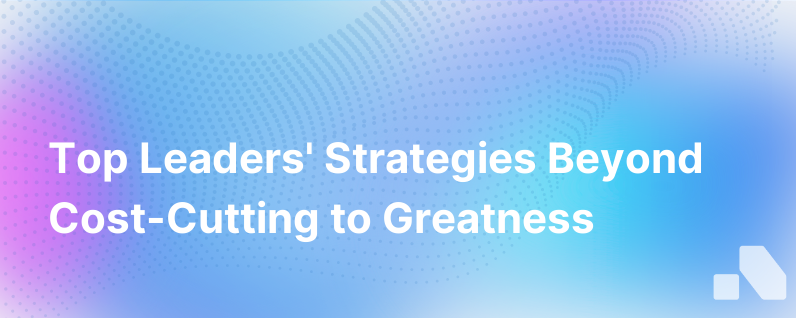Nobody Ever Cost Cut Their Way To Greatness. Heres What Top Leaders Do
Published on August 7, 2023 by David Zhang
The adage "you can't cost-cut your way to greatness" has long been heralded in boardrooms and business schools across the world. And for good reason—trimming fat from a budget might temporarily bolster the bottom line, but it rarely results in long-term eminence. Agile, forward-thinking leaders comprehend that what propels a company from mediocre to magnificent is often a cocktail of innovation, strategic spending, and investment in pivotal areas of the business.
As a marketer, understanding this philosophy is crucial for not only recognizing the actions of leading corporations but also for devising impactful strategies that twist the narrative of a brand from survival to thriving. So, what do top leaders do that sets them apart? We shall explore these strategies to provide actionable insights into achieving greatness in business and beyond.
Invest in People
At the top of many leaders' lists is investing in human capital. Greatness is achieved with teams who feel valued, are sufficiently trained, and are driven to excel. Companies exemplifying this approach often:
- Encourage continuous learning and provide professional development opportunities.
- Promote from within, spotlighting room for advancement and showing faith in their team.
- Prioritize employee well-being with excellent health benefits, flexible work arrangements, and a supportive company culture.
- Implement reward systems aligned with the company’s strategic goals, incentivizing top performance.
Innovation and R&D
Innovation isn't just about creating the newest product—it's about constant improvement and evolution. Great companies aren’t satisfied with the status quo; they are perpetually searching for better ways to serve their clients or streamline operations. IBM and 3M, for instance, famously allocate resources specifically for innovation, even when it means taking budget from other areas.
Strategic Acquisitions and Partnerships
Leadership intelligence involves recognizing when external partnerships or acquisitions can provide a technology, market entry, or capability that would be too costly or time-consuming to develop in-house. Google's acquisition of Android is a textbook example of this strategy, catapulting it into mobile software greatness practically overnight.
Prioritize Customer Experience
The customer experience (CX) is the linchpin of sustained business success. Firms that excel in this field:
- Invest in customer service and support as retention tools.
- Seek feedback and incorporate it into their product development cycle.
- Use data analytics to provide personalized experiences, fostering loyalty and cultivating brand advocates.
Embrace Digital Transformation
Adopting new technologies can streamline existing operations, unlock new opportunities, and lead to substantial long-term payoffs. Digital transformation isn't just a buzzword—it's a foundational aspect of business that can equate to enormous growth and efficiency. This often means shifting to cloud computing, big data analytics, AI, and automation.
Focus on Sustainable Practices
Sustainability isn't only about reducing a company's ecological footprint—it's also about building resilience and ensuring longevity. Practices that reduce waste and improve efficiency inherently save money and appeal to an increasingly environmentally conscious consumer base.
Marketing and Brand Development
Top leaders understand that a robust, consistent brand is invaluable. Even in times of fiscal tightening, marketing budgets are often safeguarded because brand awareness and market penetration are critical to long-term survival and success. Cutting edge marketing strategies often include:
- Content marketing to establish thought leadership and organically grow reach.
- Social media engagement to humanize the brand and directly communicate with customers.
- Customer advocacy programs to amplify positive messages.
Long-Term Vision
Effective leaders have a strategic vision that extends beyond the next quarter. This vision drives investment decisions that may not pay off immediately but will align the company with future industry trends and consumer demands.
Building Flexibility and Resilience
Modern businesses must be able to pivot quickly in response to market changes. Building in flexibility can mean diversifying revenue streams, maintaining a portion of operations as remote, or investing in cross-training for employees.
Encourage a Culture of Collaboration and Experimentation
Finally, greatness stems from a company culture that values collaboration across departments and levels of hierarchy. Spaces like Google's '20% time' allowed employees to spend one day a week working on projects that interest them, leading to such innovations as Gmail and AdSense.
In conclusion, the pursuit of greatness in business cannot be achieved by focusing solely on cost-cutting measures. The roadmap to preeminence is multifaceted, with each route—be it through people investment, innovation, or customer-focused strategies—demanding active nurturing and intelligent resource allocation. A myopic focus on the balance sheet, though it may yield short-term wins, will never unveil the true potential of a business or allow it to carve out a legacy of excellence.
Top leaders do not seek merely to survive but to thrive, and it is this distinction that delineates ordinary leadership from visionary. By emphasizing growth, innovation, and a resilient company culture, great leaders stimulate continual progress and carve paths that others in their industry may only endeavor to follow. As an AI platform that empowers sales, Aomni understands this intricate dance of zonal excellence—providing real-time analytics and tailored content not simply to succeed but to transcend the expectation of greatness.